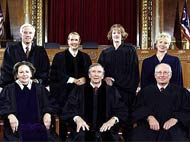 |
|


06-15-2010, 05:36 PM
|
 |
Hummer Authority
|
|
Join Date: Jun 2005
Location: Key Largo
Posts: 1,174
|
|
 Ohio Residents Beware
Ohio Residents Beware
Ohio Supreme Court Upholds Speeding Ticket By Visual Guess
Police officers in Ohio can issue speeding tickets based on sight, state supreme court rules.
 In a 5-1 decision yesterday, Ohio's Supreme Court upheld a speeding ticket based solely on how fast a driver appeared to be moving. The court considered the case of motorist Mark Jenney who drove through a State Route 21 radar speed trap operated by Copley police officer Christopher R Santimarino on July 3, 2008. Santimarino guessed based on the appearance of Jenney's black SUV that it was traveling at 79 MPH in a 60 zone. In a 5-1 decision yesterday, Ohio's Supreme Court upheld a speeding ticket based solely on how fast a driver appeared to be moving. The court considered the case of motorist Mark Jenney who drove through a State Route 21 radar speed trap operated by Copley police officer Christopher R Santimarino on July 3, 2008. Santimarino guessed based on the appearance of Jenney's black SUV that it was traveling at 79 MPH in a 60 zone.
Santimarino claimed that his thirteen years as a traffic cop and his certification in speed estimation by the Ohio Peace Officer Training Academy qualified him to make expert visual determinations of how fast vehicles are moving within 4 MPH. In court, Santimarino testified that his radar showed Jenney was traveling at 82 MPH on direct examination and 83 MPH on cross-examination.
Based on this, a district court convicted Jenney. On appeal, Jenney succeeded in having the radar evidence thrown out because the officer failed to produce the required certification documents at trial. The appeals court then ruled that the visual guess as to Jenney's speed was sufficient evidence for a conviction. Jenney appealed to the supreme court, which agreed with the lower court rulings that an officer's educated guess is sufficient to overcome that state's burden of proof beyond a reasonable doubt.
"A majority of the appellate districts that have considered the issue have held that an officer's testimony that in his opinion, a defendant was traveling in excess of the speed limit is sufficient to sustain a conviction for speeding," Justice Maureen O'Connor wrote for the majority. "Given Santimarino's training, OPOTA certification, and experience in visually estimating vehicle speed, his estimation that Jenney was traveling 70 miles per hour was sufficient to support Jenney's conviction... We hold that a police officer's unaided visual estimation of a vehicle's speed is sufficient evidence to support a conviction for speeding in violation of R.C. 4511.21(D) without independent verification of the vehicle's speed if the officer is trained, is certified by the Ohio Peace Officer Training Academy or a similar organization that develops and implements training programs to meet the needs of law enforcement professionals and the communities they serve, and is experienced in visually estimating vehicle speed."
Justice Terrence O'Donnell filed a dissent that argued the majority essentially created a standard that the police officer is always right.
"Like any other witness, a police officer's credibility is to be determined by the jury or other fact-finder," O'Donnell wrote. "In fact, jury instructions given regularly by trial judges advise that a jury is privileged to believe all, part, or none of the testimony of any witness. Thus, I would assert that a broad standard as postulated by the majority that a trained, certified, and experienced officer's estimate of speed is sufficient evidence to support a conviction for speeding eclipses the role of the fact-finder to reject such testimony and thus such testimony, if found not to be credible, could, in some instances, be insufficient to support a conviction."
A copy of the decision is available in a 50k PDF file at the source link below.
Source:  Barberton v. Jenney (Supreme Court, State of Ohio, 6/3/2010) Barberton v. Jenney (Supreme Court, State of Ohio, 6/3/2010)

|
| Thread Tools |
Search this Thread |
|
|
|
| Display Modes |
 Threaded Mode Threaded Mode
|
 Posting Rules
Posting Rules
|
You may not post new threads
You may not post replies
You may not post attachments
You may not edit your posts
HTML code is Off
|
|
|
All times are GMT +1. The time now is 02:46 AM.
|




![]() Ohio Residents Beware
Ohio Residents Beware
 In a 5-1 decision yesterday, Ohio's Supreme Court upheld a speeding ticket based solely on how fast a driver appeared to be moving. The court considered the case of motorist Mark Jenney who drove through a State Route 21 radar speed trap operated by Copley police officer Christopher R Santimarino on July 3, 2008. Santimarino guessed based on the appearance of Jenney's black SUV that it was traveling at 79 MPH in a 60 zone.
In a 5-1 decision yesterday, Ohio's Supreme Court upheld a speeding ticket based solely on how fast a driver appeared to be moving. The court considered the case of motorist Mark Jenney who drove through a State Route 21 radar speed trap operated by Copley police officer Christopher R Santimarino on July 3, 2008. Santimarino guessed based on the appearance of Jenney's black SUV that it was traveling at 79 MPH in a 60 zone. Barberton v. Jenney (Supreme Court, State of Ohio, 6/3/2010)
Barberton v. Jenney (Supreme Court, State of Ohio, 6/3/2010) Posting Rules
Posting Rules